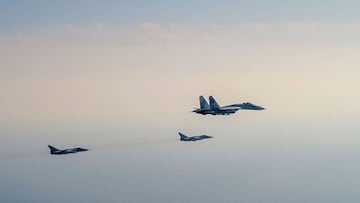How many fighter jets does Russia have?
The advance of the Russian military into Ukraine has been slower than many expected, thanks in part to aerial defences that have destroyed dozens of invading aircraft.


When Russia first invaded Ukraine in late February many experts predicted that the vast Russian military would swiftly outnumber and defeat the defending forces. However more than two weeks into the conflict Russia is still yet to have taken the capital city of Ukraine and the speed of the offensive seems to be slowing.
“The Russians have not achieved air superiority over the whole country,” a senior US defence official told reporters. “Ukrainian air defences remain intact and viable both in terms of aircraft and missile defence systems, and they’re engaged.”
However President Putin presides over the second-largest air service of any nation in the world, behind only the United States. Flying Mag reports that the Russian Air Force boasts 1,507 attack aircraft, the vast majority of which are stationed in Russia or around Eastern Europe.
Russia’s air force inventory also includes 1,837 support aircraft; 485 training aircraft; and 820 future aircraft. In total the Russian Air Force is comprised of 3,829 active aircraft.
Related news:
- Russian's strategy behind capturing Ukrainian nuclear assets
- Russia lays out demands for end to the Ukraine war
- How long can Russia fight a war in Ukraine?
Why have Russia failed to capture Ukraine?
As Putin was amassing the vast invasion forces along the Ukrainian border there was a general belief that Russia had to capability to easily overpower its neighbour. According to The Economist, Russia has spent billions of dollars on warplanes over the past decade, adding around 440 new fixed-wing aircraft between 2009 and 2020.
It was thought that Russia would quickly be able to assume aerial authority over Ukraine, allowing the Kremlin to pick off Ukrainian defences at will and paving the way for a successful land invasion.
⚡️Ukraine’s air defense forces shoot down Russian aircraft over Kyiv.
— The Kyiv Independent (@KyivIndependent) March 7, 2022
Soon after that, at 9:10 p.m., another Russian plane was destroyed in an air battle on the city’s outskirts, according to Commander of the Armed Forces of Ukraine Valerіy Zaluzhny.
Their failure in this regard is largely due to the scale and the sophistication of Ukraine’s aerial defences which have prevented Russia from gaining a foothold. Fearing that an invasion was on the cards Ukrainian officials dispersed the nation's air-defence system, making them harder to find and providing greater defensive coverage.
The invasion began with a battery of cruise and ballistic missiles trained on Ukrainian air bases but they failed to take out the aerial defences. American sources say that Ukrainian air and missile defences “remain effective and in use” and are helping to prevent the land forces from being overrun.
They have employed a two-part defence system which has reportedly taken out dozens of Russian aircraft already. Ukraine has used the Buk surface-to-air missiles to target Russian planes flying at altitude, the mobile system allowing operators to fire on enemies before quickly retreating to cover.
Their success saw Russian pilots forced to fly lower to evade the Buk’s radar system, but this only brought them into range of the smaller, shoulder-fired Stinger anti-aircraft missiles. Several videos shared by the Ukrainian defence ministry shows Russian attack aircraft being hit by this type of weapon and blown from the sky.
Russian attack helicopter shot down over Ukraine by anti-aircraft missile pic.twitter.com/VWfqJlFI2s
— Lucas Tomlinson (@LucasFoxNews) March 5, 2022
Official figures are disputed but it is clear that Ukrainian defences have eliminated a number of Russian aircraft already. Ukraine’s government claims that 39 planes and 40 helicopters have been wiped out already.
Related stories
Footage from Ukraine has been studied by Stijn Mitzer, an Amsterdam-based military analyst, who has confirmed that 11 fixed-wing aircraft, 11 helicopters and two drones have been taken out by Ukraine.
This still leaves Putin with a huge air force and vastly superior military, but there is now a sense that Russia’s failure to wrestle control of the skies above Ukraine is costing them dearly.